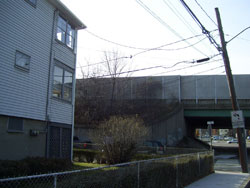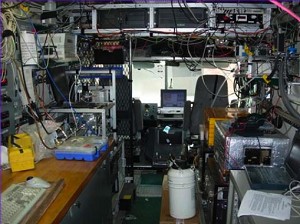
|
Don't breathe too deep if you live on Bailey Road or Mystic Avenue.
~Photo by Bobbie Toner
|
 |
 |
| The nearly "half-million dollars worth of equipment" in the air-monitoring truck.~Photo courtesy of Mystic View Task Force |
|
Pollution increases tenfold near I-93
By Jack Nicas
In
some areas around Interstate 93, there are approximately 10 times as
many airborne ultrafine particles than in other less-traveled parts of
the city, according to a study presented by the Mystic View Task Force
Wednesday.
Residents of Mystic Avenue and Bailey Road, two
areas examined in the study, could be at risk. "[Ultrafine particles]
are the first suspect in what's causing the health effects from highway
pollution," said Task Force member Wig Zamore.
Health problems
associated with highway pollution are "reduced lung function, asthma,
cardiovascular disease, [and] lung cancer," according to the study.
An
average ultrafine particle density would be "10,000 to a few tens of
thousands [per cubic centimeter]," Zamore said. The study found areas
around I-93 with 100,000 ultrafine particles per cubic centimeter, the
size of a small sugar cube.
"When you're getting 10 times the
pollution as somebody else over a long period of time, it's as if you
were smoking ten times as many cigarettes," Zamore said. "You're going
to expect that through the law of averages, your health effects are
going to be greater."
Zamore suggested leaving windows facing
the highway closed, not exercising near the highway, and the use of
high-efficiency air filters for residents within 200 meters of I-93.
The
study, which was Tufts graduate student Christine Ash's master's
thesis, relied on information gathered on a "typical winter morning"
earlier this year in the Ten Hills area. A truck outfitted with nearly
"a half-million dollars worth of equipment," according to Ash's
professor John Durant, drove around Ten Hills from 6 a.m. to 11 a.m.,
collecting air quality data.
The study found that the
ultrafine particle concentration was very high in the early morning and
then decreased as the day progressed. At 7:20 a.m. the particle
concentration 50 meters from I-93 was measured at 90,000 per cubic
centimeter; two hours later that number dropped to 30,000.
It
also showed the concentration sharply decreasing as the truck moved
farther away from the highway. At 7:20 a.m. the particle concentration
decreased by 60,000 from 50 meters to 400 meters away.
"The
study showed that the time of day and the meteorology is very
important," Durant said. "And also of course that proximity matters."
A
separate study on the city's levels of nitrogen dioxide and black
carbon, two indicators of traffic-related pollution, was also presented
Wednesday.
That study found nitrogen dioxide levels were twice
as high near I-93 than in Draw 7 Park. Nitrogen dioxide levels near
I-93 were similar to those found in heavily congested areas such as
Kenmore Square and Roxbury Crossing in Boston, said Taeko Minegishi,
the study's lead researcher.
Everyday approximately 150,000
cars travel on I-93, 50,000 on Route 28, and 20,000 on Route 38,
according to the Massachusetts Highway Department. Approximately
250,000 cars pass through the three roadways' intersection per day,
Zamore said. "There are only two or three other intersections in the
state with that much traffic," he said.
The city's heavy
traffic flow may soon present a more serious problem than traffic and
noise, Zamore said. "The number of people with health problems is going
to be proportional to both the traffic density and the population
density," he said. "Once you have both of those overlapping in a very
small area, you should expect to see a large public health problem."
|
Reader Comments